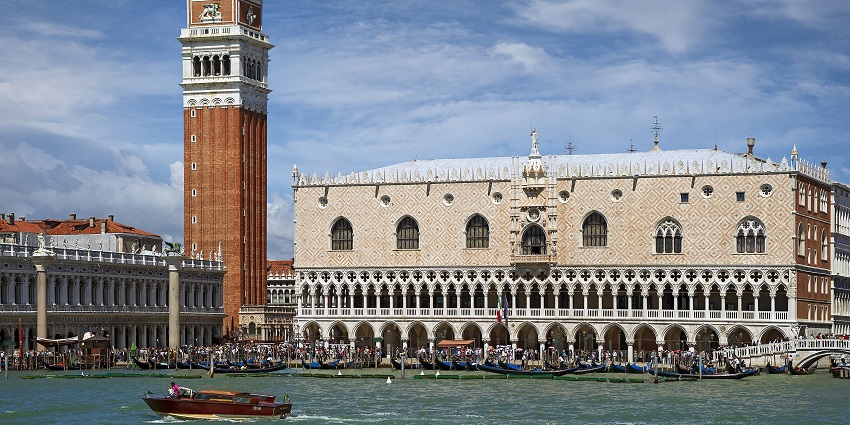Monuments in Italy represent centuries of artistic and architectural excellence spread across the country. Located in southern Europe, Italy is home to some of the world’s most visited historical landmarks. Rome, Florence, Venice, and Milan feature prominently due to their cultural significance and preserved structures. Tourists from around the world come to explore the artistic legacy that dates back to Roman times. Many of these sites are UNESCO World Heritage Sites, reflecting their global importance. From ancient amphitheatres to Renaissance cathedrals, every monument tells a unique story. Italy’s heritage invites exploration and admiration through every preserved site.
Top 10 Monuments In Italy To Visit
This list of monuments in Italy holds immense historical and cultural value, making them must-visit sites for travellers seeking depth and significance.
1. The Colosseum

Photo: Sam Valadi / Wikimedia Commons
Among the most prominent monuments in Italy, Rome, the Colosseum draws attention for its massive scale and structural ingenuity. Built in 70 AD, it remains a symbol of Roman engineering. Its subterranean passages once supported intricate stage mechanics and animal lifts. While standing inside, visitors can visualise ancient spectacles performed for thousands. Restoration has helped retain key features, allowing travellers to grasp its architectural significance. The Colosseum also borders the Roman Forum, enhancing the overall experience of this historically layered part of the city.
Major Attractions: Arena Floor, Underground Tunnels, Roman Forum
Timings: 9 AM – 7.15 PM
Entry Fee: €16 / ₹1549.25
Location: Rome
2. St. Mark’s Basilica

Photo: Helena Jankovičová Kováčová / Wikimedia Commons
As one of the most striking historical monuments in Italy, St. Mark’s Basilica captures attention with its Italo-Byzantine character. Richly decorated with mosaics and ornate columns, the church reflects centuries of artistic development. Its location near the Venetian Lagoon and proximity to the Doge’s Palace enhance its importance. The interior, adorned with gold and gems, leaves a lasting impression on visitors interested in religious history. The museum inside offers rare artefacts that shed light on Venice’s maritime past, making it a valuable site for heritage enthusiasts.
Major Attractions: Pala d’Oro, Bell Tower, Museum
Timings: 9.30 AM – 5.15 PM
Entry Fee: €3 / ₹290.48 (Church only)
Location: Venice
3. The Trevi Fountain

Photo: Vyacheslav Argenberg / Wikimedia Commons
The Trevi Fountain draws consistent interest due to its rich artistic elements and symbolic meanings. Constructed using travertine stone, it serves as an architectural expression of Baroque grandeur. The central sculpture of Oceanus represents the strength of water. People gather to admire its scale and the craftsmanship behind each figure. Traditionally, a coin tossed over the shoulder ensures a future return to Rome. The fountain remains accessible at all hours, creating a popular setting for photographers and those curious about Rome’s artistic legacy.
Major Attractions: Baroque sculptures, Aqua Virgo Aqueduct, and nearby gelato shops
Timings: 24*7
Entry Fee: Free
Location: Rome
4. The Ponte Vecchio

Photo: Ray in Manila / Wikimedia Commons
The Ponte Vecchio is a historical structure and a lively commercial space. Dating back to 1345, it was once occupied by butchers before jewellers moved in during the Medici era. The bridge spans the Arno River and remains a fixture for those exploring Florence’s artistic roots. Above the shops, the Vasari Corridor adds historical significance with its private passageway once used by rulers. It presents a chance to walk through centuries-old traditions while viewing artworks, small studios, and preserved architectural details.
Major Attractions: Vasari Corridor, Shops, Arno River Views
Timings: 24*7
Entry Fee: Free
Location: Florence
5. The Verona Arena

Photo: Arne Müseler / Wikimedia Commons
The Verona Arena offers a setting where classical architecture meets performing arts. Built in 30 AD, this Roman amphitheatre still supports grand operatic events and live performances. Its elliptical shape provides excellent visibility and acoustic clarity for spectators. Unlike many ancient structures, it functions actively today, bridging past and present. Sitting in its stone tiers, audiences can experience what Roman citizens once enjoyed. Located in the spacious Piazza Bra, it becomes a key highlight for visitors drawn to Italian cultural heritage through music and architecture.
Major Attractions: Opera performances, Roman construction, guided tours
Timings: 9 AM – 7 PM
Entry Fee: €10 / ₹968.28
Location: Verona
6. The Royal Palace Of Caserta

Photo: Carlo Dell’Orto / Wikimedia Commons
The Royal Palace of Caserta combines administrative functionality with artistic expression. Commissioned in the 18th century, its expansive design includes over 1,200 rooms and multiple courtyards. The structure mirrors French and Italian styles with intricate ceilings and marble floors. Gardens behind the palace extend over kilometres, housing sculptures, fountains, and carefully designed paths. The interior exhibits include throne rooms, galleries, and period furniture, offering insight into royal life. Recognised by UNESCO, it remains a pivotal location for those studying European architectural traditions.
Major Attractions: Grand Staircase, Royal Apartments, Park and Gardens
Timings: 8.30 AM – 7.30 PM
Entry Fee: €15 / ₹1452.42
Location: Caserta
7. Milan Cathedral

Photo: Dudva / Wikimedia Commons
The Milan Cathedral stands as a prime example of Gothic design with its spires, carvings, and statues. Construction began in 1386, and the project spanned generations, involving numerous architects and craftsmen. The sheer scale is evident in its 135 spires and thousands of sculptures. Visitors ascend to the roof to see these details up close, along with views of the city. The stained glass windows depict scenes from the Bible and Italian history, adding educational value. It’s a key site for those interested in medieval craftsmanship.
Major Attractions: Rooftop View, Statues, Stained Glass Windows
Timings: 8 AM – 7 PM
Entry Fee: €5 / ₹484.14 (Cathedral only)
Location: Milan
8. The Uffizi Gallery

Photo: Morio / Wikimedia Commons
The Uffizi Gallery offers visitors a deep dive into the evolution of European art. With works by Botticelli, Michelangelo, and Da Vinci, the gallery tells the story of Renaissance creativity. Organised by period, its rooms guide viewers through shifts in style and subject matter. Besides paintings, it also features rare sculptures, manuscripts, and historical artefacts. Many come to see Botticelli’s “Birth of Venus,” but leave impressed by lesser-known works. The gallery’s layout encourages slow exploration, making it ideal for those studying artistic progress and patronage.
Major Attractions: Birth of Venus, Primavera, Annunciation
Timings: 8.15 AM – 6.30 PM (Closed Mondays)
Entry Fee: €12 / ₹1161.47
Location: Florence
9. The Sassi Di Matera

Photo: Superchilum / Wikimedia Common
The Sassi di Matera presents a view into an ancient way of living, with dwellings carved into the limestone. These cave homes date back thousands of years and were inhabited until the 20th century. Visitors walk through narrow alleys, viewing chapels and living quarters shaped from rock. Some of the structures now function as museums and hotels, preserving both use and heritage. The entire zone highlights traditional methods of adaptation to the environment and climate. Its World Heritage status supports ongoing conservation and educational projects.
Major Attractions: Cave Churches, Rock-hewn Homes, Matera Cathedral
Timings: 24*7
Entry Fee: Free
Location: Matera
10. The Leaning Tower Of Pisa

Photo: Joseolgon / Wikimedia Commons
The most famous monuments in Italy, the Leaning Tower of Pisa intrigues visitors with its abrupt tilt. Originally designed as a vertical structure, soft ground caused it to lean shortly after construction began in the 12th century. Restoration has reduced the angle, making it safe for entry. Visitors can climb its spiral staircase to reach the top for a view of the surrounding area. Situated in the Piazza dei Miracoli, it’s surrounded by other historic buildings, offering a complete experience for travellers.
Major Attractions: Bell Tower Climb, Pisa Cathedral, Baptistery
Timings: 9 AM – 8 PM
Entry Fee: €20 / ₹1935.78
Location: Pisa
Monuments in Italy offer insight into centuries of architectural progress, artistic excellence, and cultural significance. Travellers can witness distinct periods of history through structures that speak of craftsmanship and ingenuity. Each site brings a fresh understanding of its era, inviting reflection and admiration. Book your historical exploration with TripXL to access exclusive guidance, thoughtful itineraries, and a closer connection to Italy’s remarkable past.
Cover Photo: Kevin Poh / Wikimedia Commons


 WhatsApp
WhatsApp
 Twitter
Twitter









